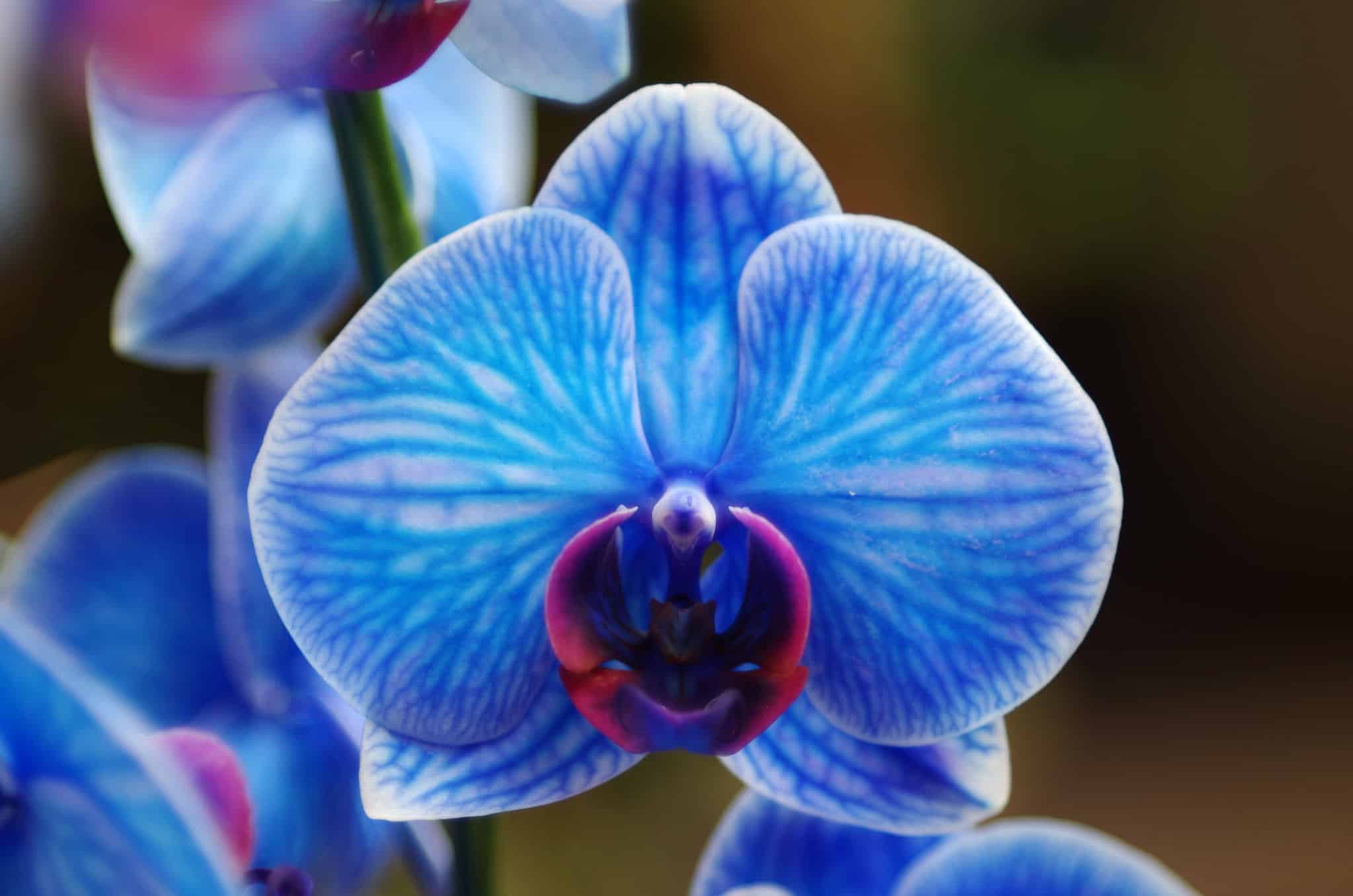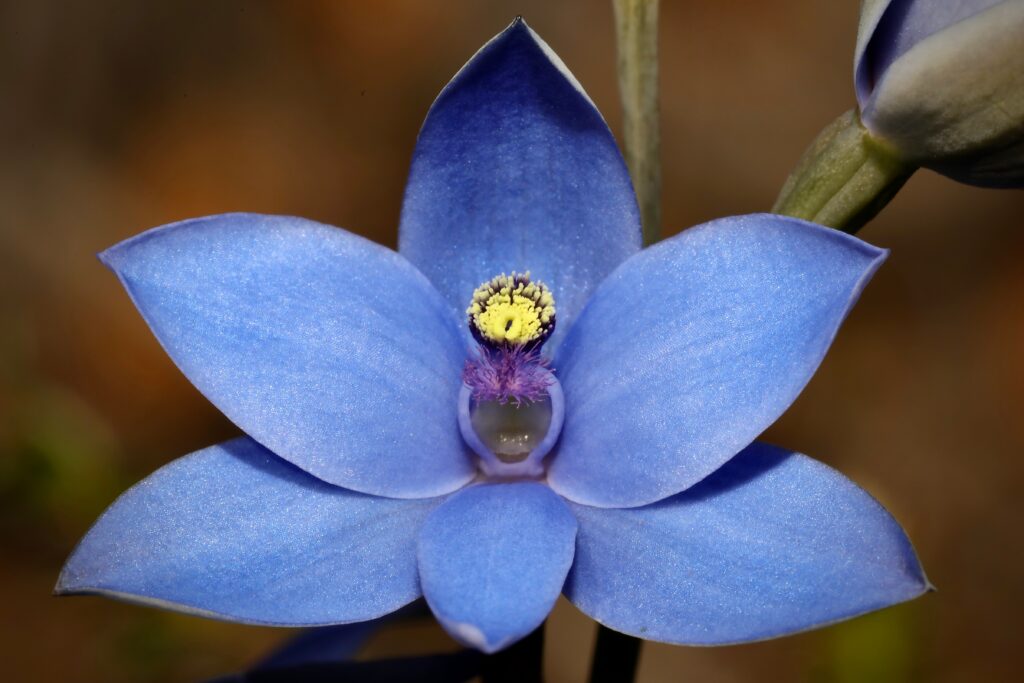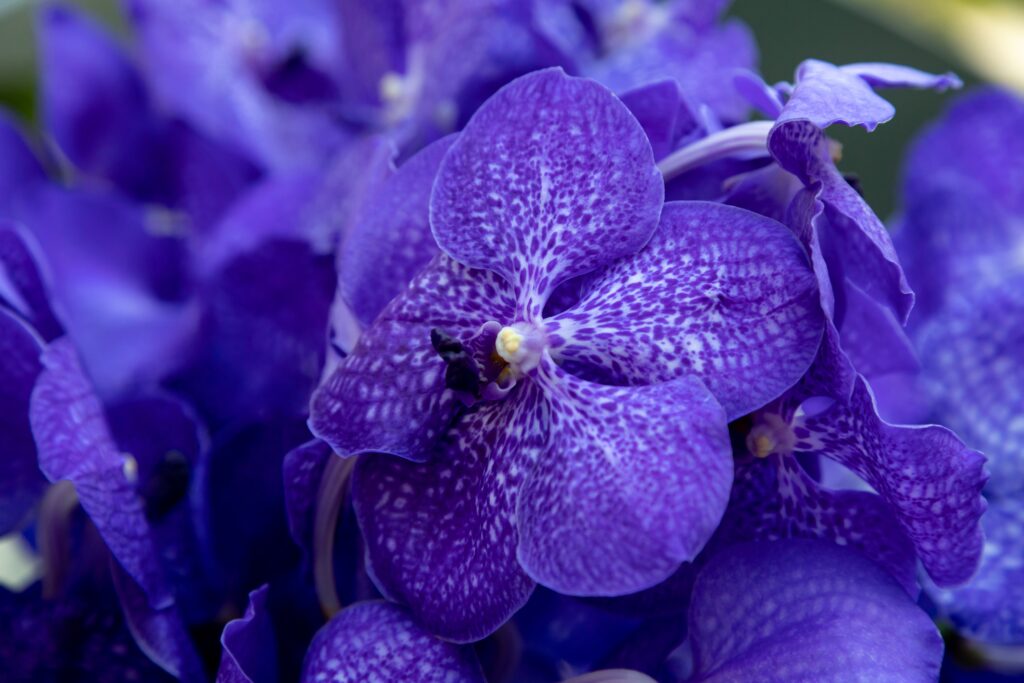In the world of orchids, blue flowers are quite rare and sought after. If you’re looking to add blue blooms, especially naturally-occurring species, into your collection, you may find the selection less abundant than other colored orchid flowers. However, it’s certainly not impossible to find a blue orchid that works for your growing environment.
In this guide, we’ll discuss the orchid family and then cover three gorgeous blue orchids, their native growing regions, morphologies, and specific care requirements.
Let’s dive in!

In the world of orchids, blue flowers are quite rare and sought after.
Orchids: Botanical Classification
Representing the second-largest family of flowering plants, Orchidaceae includes almost 30,000 species. Growing from lowland jungles to mountain peaks, clinging to rocks and tree bark, and spreading their roots throughout a range of soils, these fascinating plants have evolved for 112 million years to thrive on our planet.
Three Beautiful Blue Orchids
Blue flowering plants are rather uncommon across species. In fact, fewer than 10% of the planet’s almost 300,000 flowering species have blue blooms. You may find commonly available “blue” orchids in stores, but the vast majority of these are actually injected with a blue dye and will rebloom in their natural color (usually white). There are only a handful of naturally occurring blue orchids, and we’ll provide you with the following three blue beauties:
- The Blue Aganisia Orchid (Aganisia cyanea)
- The Blue Lady Orchid (Thelymitra Crinite)
- The Blue Vanda Orchid (Vanda coerulea)
Enjoy learning about these uncommon blue orchids below.
1. The Blue Aganisia Orchid (Aganisia cyanea)
Found natively growing in tropical regions of Brazil, Venezuela, and Colombia at elevations of about 300 to 1,500 feet, this hot-loving, epiphytic orchid can handle significantly more moisture than most orchid species. In its native environment, the blue aganisia orchid (Aganisia cyanea) is often subjected to the flooding of the Amazon river in which only its flowers remain above the water line. This species is synonymous with Acacallis cyanea. It is one of only four species in the tiny Aganisia genus.
Morphology
The blooms on this orchid are softly beautiful and delicate-looking. The sepals, or outer whorl, of this orchid, are pale blue with shades of darker blue around the wavy edges of the top, or dorsal, sepal. The two lateral petals, or inner whorl, share the same coloring as the dorsal sepal, and also feature wavy margins. The labellum (modified lower petal, or lip) is a much darker blue-purple and shaped like a small pair of wings folding outward.
The leaves of the blue aganisia orchid are glossy, light green, ovate-to-elliptical shaped, and have smooth, entire margins. Blooming from late winter through late spring, these 2.5-inch wide flowers emerge at clusters of 3-10 atop a 10-12 inch long upright, bare raceme.
Plant Care
Caring for Aganisia cyanea is similar to that of most lowland tropical epiphytes, with the caveat of its increased watering requirements. Below, we’ll provide detailed care guidelines for this beautiful blue orchid.
Watering
Quite water-loving, this orchid requires consistent moisture, with only a slightly drier period in the winter. A good strategy during the growing season for the blue aganisia orchid is to mist the roots and growing medium twice a day and thoroughly water via soaking twice a week. For this species, it’s best to not let the roots fully dry out, even in the winter.
Light
Medium-to-bright indirect sunlight is appropriate for this species of orchid. Avoid exposing this plant to afternoon full sun, but a couple of hours of morning full sunlight is fine. Ideally, keep this light exposure schedule year-round.
Temperature and Humidity
Temperatures are fairly consistent year-round for the blue aganisia orchid. Aim to provide daytime temperatures between 80-90 degrees Fahrenheit and night temps between 68-73 degrees Fahrenheit. Humidity is also fairly stable throughout the year with a slight dip in the winter. During spring, summer, and fall, try to maintain 75-80% humidity for this tropical orchid. During winter, the humidity level can drop to 70%.
Growing Medium and Fertilizer
Providing rapidly draining, aerated soil is crucial for this species, especially because you will need to water it often. As an epiphytic orchid, your best bet is to mount this plant to bark such as hardwood barks, cork bark, or to compressed tree fern root. If you live in a region where maintaining high humidity is difficult, you can plant in slotted wooden baskets in a soilless growing medium to help the plant retain more moisture. In this case, the best growing medium is a 1:1 ratio of shredded tree fern fiber and chopped sphagnum moss with perlite and charcoal additives.
The blue aganisia orchid does best during its active phase with weekly fertilizing of balanced, water-soluble orchid fertilizer at 1/4 the dosage strength. To prevent mineral build-up on this orchid’s particularly sensitive roots, thoroughly flush the roots and growing medium once a month. During fall, you can switch to feeding with a high-in-phosphorus, low-in-nitrogen mix to promote flower spike formation in the late winter. Cut back on fertilizing only once a month during winter, and only fertilize when watering.
2. The Blue Lady Orchid (Thelymitra crinita)

is considered a sun orchid and produces beautiful blooms with a vivid blue hue.
©OziNatives/Shutterstock.com
Native to the southwest regions of Western Australia, the blue lady orchid (Thelymitra crinita) is a terrestrial species that belongs to a genus commonly referred to as sun orchids due to their tendency to bloom after exposure to increased sunlight. The Thelymitra genus contains about 80 species of terrestrial tuberous orchids native to parts of Australia, New Zealand, and islands just north of Australia. They’re typically distributed throughout higher rainfall areas of their native range and are usually found in partially-shaded forests and scrublands.
Morphology
The blue lady orchid, at first glance, may not look quite like a “classic” orchid. The sepals and lateral petals are similarly sized, shaped, and colored, and the labellum is only distinguished due to its more elongated, narrower form. The blooms cast an eye-catching, vivid blue hue. The column of this orchid is also blue with a yellow crest.
This plant produces a single 2-6 inch long leaf that emerges from the base of the plant and grows in an arching form. Typically, 2-15 flowers 1-2 inches wide are borne along an upright to arching stem 8-30 inches tall.
Plant Care
Growing Thelymitra crinita can be challenging and isn’t considered beginner friendly. If you’re experienced with growing orchids, especially those native to Australia, you may be in a position to enjoy their stunningly blue blooms. Below, we’ll discuss what is needed to help this terrestrial orchid thrive.
Watering
Interestingly, sun orchids, including the blue lady orchid, are summer dormant species. In their native environments, summers are dry, and winters are rainy, so the plants rest during the summer. As such, you’ll need to provide consistent water during the active growing period of early fall through late spring.
The blue lady orchid is fairly drought-tolerant, so you can allow the growing medium to dry between watering. During summer dormancy, water only sparingly. When late summer arrives, you can begin slowly watering and exposing your plant to cool nights, which will help stimulate growth.
Light
Growing in semi-open scrublands and woodlands, this orchid thrives in bright, indirect to full sun exposure. Remember, this orchid needs ample sunlight to trigger flowering.
Temperature and Humidity
A rather hardy species, this plant is both drought and cold-tolerant, frost hardy down to about 25 degrees Fahrenheit. For reference, in this plant’s native growing region, temperatures typically average between 85-90 degrees Fahrenheit during the day in the summer and between 45-50 degrees Fahrenheit for daytime winter temps. Humidity levels should correspond with hot, dry summers and cool, rainy winters.
Growing Medium and Fertilizer
The blue lady orchid thrives in acidic (5.0-6.0 pH), well-draining, aerated soils. Your best bet is to pot this plant in a mixture of 80% seramis (large-sized clay grains), perlite mixture, and 20% pine bark (adds acidity and structure). Starting in early fall, begin fertilizing once per month with a balanced, water-soluble orchid fertilizer. By winter, fertilize weekly with water. Once the orchid flowers, you can begin to reduce watering and fertilizer application.
One tricky aspect of growing this orchid species is that it relies heavily on its symbiotic plant-fungi relationship. Some growers have found consistent flowering success with this orchid by cultivating its fungal partner.
3. The Blue Vanda Orchid (Vanda coerulea)

has stunning blue blooms, featuring an outer whorl of large rounded sepals densely checkered with a blue and white pattern.
©LariBat/Shutterstock.com
Native to cooler areas of India, Myanmar, and Thailand, this evergreen, epiphytic orchid grows on tree bark in open woodlands at about 2600-5600 feet. This orchid is considered one of the few “true blues” in the Orchidaceae family.
Morphology
Producing stunning blue blooms, this orchid features an outer whorl of large rounded sepals densely checkered with a blue and white pattern. The dorsal sepal is often a bit smaller than the lateral sepals. The lateral petals are relatively the same in size, coloration, and shape as the dorsal (top) sepal. The labellum on this species is quite small and features a v-shaped, blue-purple lip.
This plant produces about 20 evergreen, narrow, long, and blade-like leaves that emerge in an alternating pattern as they climb up a thick stalk. The leaves can range from 3-10 inches long and are typically about an inch wide. In the fall, 4-6 inch wide flowers bloom, emerging toward the top of a branching, bare stem.
Plant Care
If you’re looking for a simple blue orchid to care for, this is the one for you. As long as you follow the below guidelines you should do just fine.
Watering
During its active spring and summer growth period, water consistently, avoiding allowing the roots to dry out. Start to reduce watering in the fall, and cut back to only water sparingly in the winter.
Light
The blue vanda orchid tends to require quite a bit of light. You’ll need to provide at least very bright, indirect light or full sun in the morning, followed by filtered light. The leaves of this plant should be light green, so if you notice dark green leaves, you’re not providing enough sunlight.
Temperature and Humidity
Ideally, you’ll want to provide summer daytime temperatures between 75-85 degrees Fahrenheit and night temps between 60-65 degrees. Winter temperatures should fall between 70-75 degrees during the day and 45-50 degrees Fahrenheit at night.
In the blue vanda’s native environment, the humidity range in summer is typically 80-85% and 50-55% in the drier winter.
Growing Medium and Fertilizer
During its growing period, fertilize weakly weekly with 1/4 strength water-soluble, balanced orchid fertilizer. You can start feeding with a high-in-phosphorus, low-in-nitrogen fertilizer to encourage fall blooms by mid-summer. Cut back to only fertilizing about once a month in the winter.
This epiphyte does well potted with a coarse medium of tree fern, charcoal, and perlite. You can also mount this plant on tree fern slabs. Just make sure to monitor watering if growing on slabs as you may need to increase to compensate with misting for notably fast root drying.
The photo featured at the top of this post is © LariBat/Shutterstock.com
Thank you for reading! Have some feedback for us? Contact the AZ Animals editorial team.







